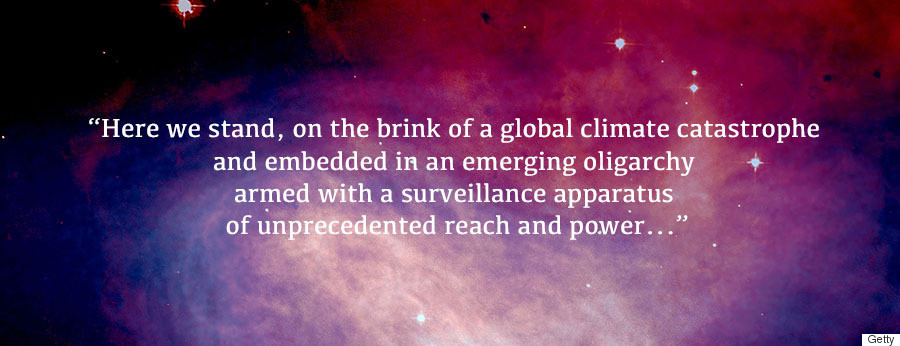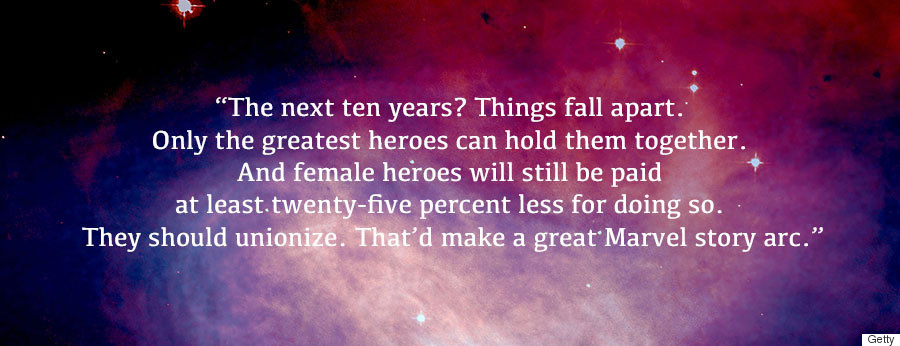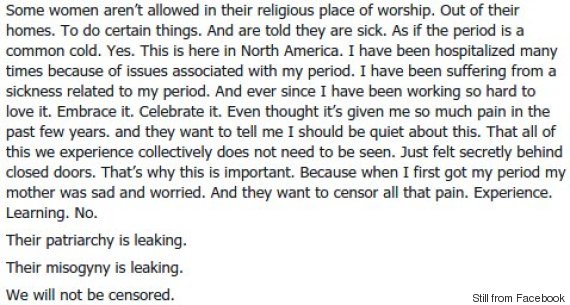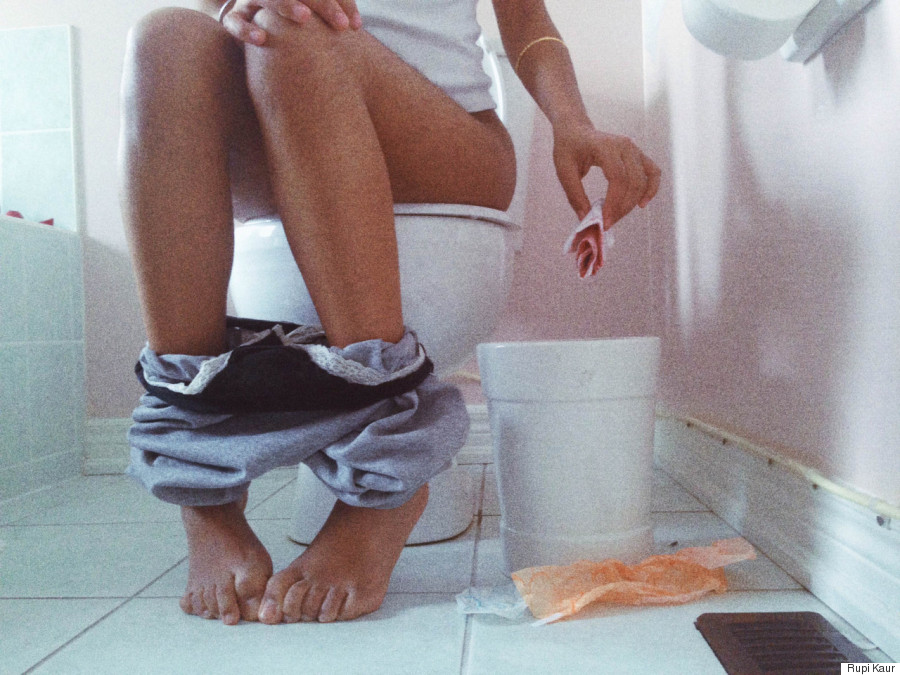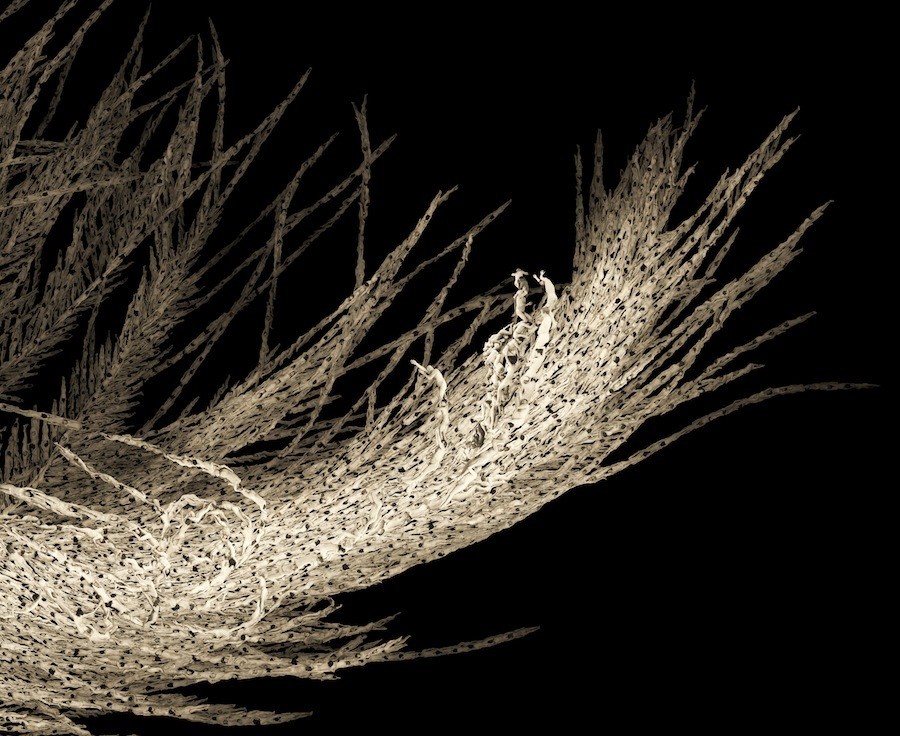![future]()
In the epilogue to his book on data, privacy, copyright and what the changing tides of these big ideas mean for writers and other creative types, prolific sci-fi behemoth and tech blogger
Cory Doctorow tries to guess what the future will hold. He begins with a disclaimer: “Science-fiction writers are terrible at predicting the future. But that’s okay. Everyone is terrible at predicting the future. Every significant fact about the future is unguessably weird. Only the trivial is subject to exploration.”
Scores of speculative authors have backed this claim, including Margaret Atwood and Ursula K. Le Guin. But that doesn’t stop us from relying on their imaginative minds, and the careful forethought they’ve given to constructing worlds different from our own, to inform our conception of what’s to come.
As a whimsical thought experiment, The Huffington Post asked 10 science-fiction, speculative fiction, urban fantasy and dystopian authors to answer a single question: What will the next 10 years bring? Will drones become omnipresent? Will the already dissipating line between our gadgets and ourselves fade further? Or, will things remain, more or less, the same? Read what Edan Lepucki, Jo Walton and others had to say:
David Walton author of Superposition:
"In the next 10 years, the earliest adopter of new technology might just be your grandmother.
Of all the fields in which dramatic changes might be seen in the next decade, the field of home automation is the one poised to explode. For most of us, the ability to turn on our ovens from our phones or watch a robot clean our floors is little more than a novelty to impress our neighbors and friends. To the elderly or infirm, however, it could mean the difference between disability and independence.
In the next decade, we’re going to see a revolution in automated assisted living. Imagine a simple rolling robot that comes when you call, presenting you with a video screen that reminds you of your daily schedule. Totally voice-activated, it can control your lights and door locks, oven and water temperature. It keeps track of the food in the house and can order more when necessary. It can connect you with family and friends through video conferencing, or simply read you a book. It gives you your medicine when you need it, keeps track of where you left your glasses, and -- through wearable health monitors -- can call your family or your doctor if you need urgent medical help.
The technology is nearly ready, and immense government investment will be inevitable in the coming years, as baby boomers age and live longer than ever before. Those hesitant to try new things will be won over when it gives them the power to maintain their independence. Ten years from now, when you visit your parents or grandparents, they may very well have better technology than you do!"
![scifi1]() Elizabeth Bear, author of Karen Memory:
Elizabeth Bear, author of Karen Memory:
"I think one of the biggest trends of the next decade -- and beyond -- is also one of our greatest hopes for a post-scarcity economy. As technology makes sharing the use of physical as well as virtual objects more feasible, we'll be seeing less need for people to own individual "stuff" and more opportunities to amortize costs across groups. Essentially, it amounts to more sharing through rentals, co-ops, and so forth. If you need to use a lawnmower for three hours a week, basically, it really doesn't make a lot of sense to own your own lawnmower when you can go in with your neighbors and buy several to share -- or when a business can set up something like a tool club, where you subscribe and then borrow what you need.
We're already seeing a good deal of this in urban centers, with bike- and car-sharing programs. There are even wardrobe-sharing programs one can subscribe to. As the technology for tracking and sharing useful objects improves, I expect it to infiltrate less densely populated areas, as well."
Robert Charles Wilson, author of The Affinities:
"I’m tempted to repeat the old adage that science fiction doesn’t predict, it speculates. But science fiction does make one prediction that always comes true, and it’s the deep Heraclitian truth at the heart of the genre: change happens. Change is inevitable. It devours everything familiar and builds strange new structures on the quicksand of contingency. Step in the same river twice? Kid, we don’t even have that river anymore. We paved it over back when the rain stopped falling.
So what might be new and different in the next 10 years? We can start by asking what’s already beginning to feel old. And what feels old (to me) is our political and economic discourse. Here we stand, on the brink of a global climate catastrophe and embedded in an emerging oligarchy armed with a surveillance apparatus of unprecedented reach and power, discussing politics in terms Victorian philosophers would have recognized. There is a tinderbox of unmet expectations and frustrated idealism out there, and a genuinely captivating new political or economic idea -- good or bad -- could start a global conflagration.
How might such an idea arise? I would point at recent progress in cognitive science. We’re standing on the verge of a profound new understanding of the one subject Enlightenment philosophy could never really get a grip on: human nature. As we come to know ourselves better, we’ll begin to understand our political and social behavior differently -- and, inevitably, we’ll find ways of manipulating and modifying that behavior. And how will that play out? Beats me. I’m just a science-fiction writer. But it invites some interesting speculation."
![schifi2]() Jeffrey Rotter, author of The Only Words That Are Worth Remembering:
Jeffrey Rotter, author of The Only Words That Are Worth Remembering:
"Ten years ago, Adam Sandler shot a movie in my neighborhood. Much of the film, as far as I could judge, involved an aerial shot taken from a helicopter that hovered for several hours five or six feet above my apartment. After calls to 911 and Gracie Mansion yielded no results, I climbed through my roof hatch, hoping to persuade Mr. Sandler’s helicopter to fly away. As I flailed my arms, dressed seductively in boxer briefs and baby spit-up, I thought to myself: 'Maybe one day I’ll be able to control air traffic with my mind.'
A decade on, I’ve added many more nuisances to the list of things I wish I could control telepathically. Today, that same scene could be filmed using a drone. Adam Sandler could sit in a posh Burbank suite, eating a Green Monster smoothie sandwich while watching me hop around a Brooklyn rooftop in my underpants. The future is now.
What further improvements could 2025 possibly bring? I’m hoping for more drones, more half-dressed rooftop outrage, more auteurs compiling shame into box-office gold. We’ll all get a chance to stand on the roof as the drones circle, capturing our useless pleas for privacy from only the sexiest angles. This will be the entertainment of the near future, and an Adam Sandler movie I’d like to see."
Brenda Cooper, author of Edge of Dark:
"Connected health care will occur at a whole new level. When I wake up, I’ll feed the dog special food designed for her. While it’s hydrating, I’ll check my own readouts from my wrist or from a small screen on the fridge. That will tell me which supplements to take that morning, and in what dosages. I’ll measure that out and have it with a tall glass of cool water before my morning coffee. After I wake up, the dogs and I will run, and I’ll be able to use my connected sunglasses to keep track of both of our heart rates. When we arrive at the park, I’ll turn everything off and enjoy some long moments of mindfulness while I throw a Frisbee for the dog, and then we’ll turn back on and check in for advice about whether to run or walk back home.
Later that morning, I’ll get an alert that a cancer marker has shown back up in my bloodstream, and a special test will be ordered right there. I’ll feel a light prick in my wrist. An hour later the results will go into a machine and queue up for an analytics run. The line will be a few hours long, so I’ll try and ignore my fear, but fail hard enough that I fall down the last stair to my office, and have to catch myself. After standing still for a moment and catching my breath, I’ll be told I’m okay, and so I’ll go to work. By lunch, my analytic results will be available and I’ll learn that there is no statistical reason for worry, but a note had been sent to my personal diagnostics machinery to add a more refined test and that two foods have been removed from my recommended diet."
![scifi3]() Genevieve Valentine, author of Persona:
Genevieve Valentine, author of Persona:
"New York's the same as ever, mostly. The water level's up another two feet, but since they've moved the polar bears to Roosevelt Island, it just means more tourist money for the Tramways. (The network in Brooklyn is going to look like a spiderweb, but the hipsters want what they want.) The president's newest movie just premiered here, and she scored so well on the red carpet that we probably won't have to hold elections this year. (If that exoplanet radio signal checks out, she'll be a lock for the full four.) The Upstate Exodus Initiative is as big a mess now as it was when it was introduced; seven grand for a studio on high ground, and still nobody's leaving. They're starting to eye the end of Brooklyn again, something about solar panels and ways to avoid electrocution. You're not going to get anybody down there. That water's too rough to live in. No one's managed the swim out to the Wonder in two years; the waves suck you in and you never come out. Still, the cars that are visible above the water line are holding up. Seagulls nest in them now. It's nice; it brings the tourists."
Ken Liu, author of The Grace of Kings:
"It is not necessary for AI to pass the Turing Test to have a significant impact on the labor market.
News organizations are already benefitting from automated analysis and story generation. Since many office jobs involve not much more than recasting numbers and charts in formulaic prose, it’s not hard to imagine that in 10 years automation will make more inroads in content generation and replace much of the basic writing and analysis we rely on humans to do today.
Similarly, automation will transform the transportation industry. Even if most car owners prefer to continue to drive their own vehicles for psychological reasons, the trucking industry will adopt automated vehicles to improve safety, increase efficiency (automated cars don’t have drivers who need to sleep), and reduce costs.
Even domains requiring human expertise like law and finance will be affected. First, computers will begin to do things that humans simply can’t do. Algorithmic trading, data-driven analysis, and electronic discovery will lead to insights that cannot be derived by human analysts and lawyers. Second, automation will make it possible to build robust infrastructure and processes that allow clients to tap into human expertise globally. It makes no sense for clients to pay the kind of hourly rates they do right now to first-year law firm associates for basic research when such research can be done cheaper on the other side of the globe.
The biggest obstacles standing in the way of many of these oncoming revolutions are not technical, but legal. Laws and regulations have so far inhibited the more wide spread adoption of automation, but the trajectory is clear. Interest groups standing to benefit from the use of automation will push for the necessary changes, and I suspect that the next 10 years will see many of these conflicts played out in our legislative bodies and courts. But the long term transformation of the labor market due to machines replacing brains will only become clear in another generation."
![scifi4]() Edan Lepucki, author of California:
Edan Lepucki, author of California:
"In the next 10 years, we will see, unfortunately, a return to a baggier fashion silhouette for men, and a renaissance of early-1990s thin eyebrows for women. Thankfully, the male top-knot, a popular hairstyle among certain hipsters, will go woefully out-of-style, and beards will only remain on those with weak chins. With the end of 'Mad Men,' we'll let go of our obsession with mid-century modern furniture and some of us will even gravitate toward the shabby-chic look again.
Over the next 10 years, we will see a deeper bifurcation when it comes to technology. One segment of the society will become more and more reliant on computers and such, going so far as to embed microchips in their children and phones in their own eyeballs; others will eschew technology altogether and will advocate for no-phone-use zones in public areas, a la non-smoking sections at restaurants. By the end of the decade, someone will try to marry a robot. Marijuana will be legal in most states. It will be harder and harder to get an abortion, especially in the conservative states. George Clooney will run for office. Websites will be forced to find a sustainable revenue model for paying their writers. My son will be a teenager. I will need reading glasses to read all the terrific novels that are sure to be published. Don’t even ask me about the California drought or police brutality... my crystal ball is cloudy and cracking."
John Birmingham, author of Emergence:
"Over the long arc, as Yeats observed, things fall apart. If you’re looking for a hedge bet on the big narrative moves of the next 10 years, put your money on the end of the world as we know it. The apocalypse has always sold books and tickets, from the very first Bible to the 'Independence Day' reboot.
Genre fiction is a junkie, mainlining the anxieties and obsessions of its time. Soviets beat you into space? Spend the 1950s making movies about the threats from the stars. Society devolving into a mindless and insatiable consumergeddon? It’s zombie time! And at the core of modern anxiety? The loss of control. Over ourselves, and over the world. I think as we feel even less certain of everything, we’ll look even more to superheroes for the vicarious thrills of extreme coping strategies.
It’s interesting that they haven’t made the leap from big screen to printed page in any notable way. Batman would make great literary fiction -- all that dark and broody introspection… with punching! And if Hollywood refuses to respect the legit claims of female superheroes -- seriously Marvel, no Black Widow merch? For shame! -- inevitably someone like Gillian Flynn or some old school book-writing maven will show them how it’s done. Margaret Atwood could update Wonder Woman!
The next 10 years? Things fall apart. Only the greatest heroes can hold them together. And female heroes will still be paid at least twenty-five percent less for doing so. They should unionize. That’d make a great Marvel story arc."
![scifi5]() Jo Walton, author of The Just City:
Jo Walton, author of The Just City:
Tomorrow's trends swirl in a pixel glow
Shaken and stirred and tipped in cups to go:
Drink deep, peer close, guess what we cannot know.
Ten years is long, and yet, not long enough,
Changes sift down unseen, or fast and rough,
In politics, in tech, in fights, in fluff.
Upon this planet shall be constant war,
Cod will come swarming back to Iceland's shore,
Today's new fads become a facile bore.
Nations will borrow all the banks will lend.
We will print perfect statues, and this trend
Will fill our houses with them, and then end.
With oracles reopening in Greece,
One war will end in unexpected peace,
Others go on and on with no surcease.
The unheard find a voice and have their say.
China and Spain declare free marriage day.
Democracy comes to the USA.
Fast and ubiquitous and very neat,
The word "computer" becomes obsolete.
As screens you cannot touch seem incomplete.
One thing you'd never guess will catch on here.
Mummies and Termites cause box office fear.
Cold fusion will be very very near,
Old age will keep receding as we age.
Books become beautiful on every page.
The net will bring us friendship, hope, and rage.
Doctors do miracles, but people die,
We'll get no closer to a reason why.
We send more robots up to search the sky.
But I'll still write in Protext '91,
And you'll get famous and have lots of fun,
And all the best of life be just begun.
Thus incrementally, as lives unfold,
We'll change unnoticing until we hold
Our different world the same, its tale untold.
Bad mixed with good, safe, scary, normal, strange,
Ten years of human choice and human range,
The only certainty in life is change. -- This feed and its contents are the property of The Huffington Post, and use is subject to our terms. It may be used for personal consumption, but may not be distributed on a website.









